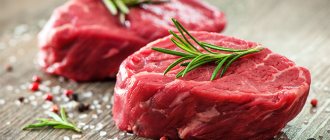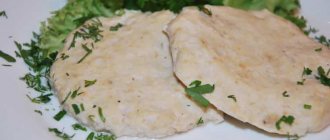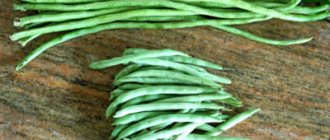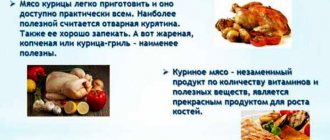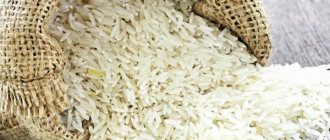Pork is pig meat, which is characterized by the presence of a fatty layer and a soft pink color when cut. This product is consumed both in northern and southern countries. Pork is prohibited only for those who preach Islam and Judaism.
This product is rich in B vitamins, which are superior in quantity to those found in beef. Pork is also rich in vitamin PP, iodine, calcium, potassium, iron, zinc, and copper.
How many calories are in fried pork?
Although pork is not a dietary product, we couldn’t help but write about the calorie content of this tasty meat, because boiled or stewed, many people who are losing weight enjoy eating pork, along with a side dish of tasty and healthy cereals. But how many calories are there in pork and how does the calorie content of this meat change depending on the preparation.
Interesting fact: pork is the most easily digestible meat after lamb. Pork fat is less harmful to the heart and blood vessels than beef fat. 100 g of pork meat contains 2.98 g of fat, and the same amount of chicken contains 3.03 g.
In addition, pork contains a very large amount of vitamins from group B, compared to other types of meat: B1, B2, B3, B6 and B12. It contains a lot of protein, so nursing mothers are advised to include pork feet in their diet, as this meat promotes the formation of breast milk.
Of all types of meat, pork has the highest calorie content.
What is the disadvantage of pork meat?
Despite the beneficial properties and many B vitamins, pork, consumed frequently and in large portions, leads to disruption of metabolic processes in the body.
Often, the question of how many calories are in pork is not of much concern to those suffering from obesity, while they satisfy their hunger with large portions of boiled rather than fried meat.
As a result, shortness of breath appears, serious illnesses develop and fat accumulates at a tremendous speed.
Pork meat can be contaminated with dangerous parasites. Therefore, it is recommended to give it good heat treatment, otherwise a person may face helminth infection and even death.
Pork carcass parts and calorie content
It is customary to divide this meat into two types:
- The first includes the less fatty parts of the animal: shoulder, loin (back), brisket, lumbar part, ham.
- The second type is defined as those pieces that contain layers of fat: neck, shank, drumstick.
Below is information about the calorie content of raw pork carcass parts. calorie content per 100 g
- Calorie content of pork shoulder 250 kcal
- Calorie content of pork loin (back) 180 kcal
- Calorie content of pork belly 550 kcal
- Calorie content of the lumbar part of a pork carcass is 270 kcal
- Calorie content of pork ham 300 kcal
- Calorie content of pork neck 340 kcal
- Calorie content of pork knuckle 330 kcal
- Calorie content of pork shank 257 kcal
Fried pork: calorie content and harm of the product
Fried meat is known to be harmful to the body, since pork contains a lot of cholesterol. A lot of growth hormones also have an unfavorable effect on the body’s condition.
The calorie content of fried pork increases as a result of adding large amounts of fat for frying. Therefore, it is important to know how to properly prepare meat dishes.
For frying, you need to use a non-stick pan, as a result, less oil will be used for cooking, and your body will not suffer from the extra calories of pork.
As you age, you need to consume meat in limited quantities, especially for older people. They will not count pork calories, but large portions of pork meat contribute to tissue destruction and the occurrence of inflammatory processes.
Those who are overweight should avoid eating fried cutlets, meatballs, schnitzels and other hearty dishes. Before eating a meat dish, you need to calculate how many calories are in pork, and what this means in a particular case.
If you add a minimum amount of fat to the meat during frying and prevent burning, you can significantly reduce the harmful effects of the product on the body.
The calorie content of boiled pork will be slightly lower than meat cooked according to all the rules in a frying pan.
Fried pork is prohibited for persons who have problems with the digestive system, diabetes, atherosclerosis, or cardiovascular diseases.
If you are asking about weight loss or dietary nutrition, then the calories in fried pork do not allow this type and method of cooking meat to be classified as dietary products.
How many calories are in pulled pork?
How many calories are in stewed pork? Stewed pork is a delicious dish and can be cooked with the addition of various vegetables, which will further improve the taste of the dish.
The calorie content of stewed pork will be lower than the calorie content of boiled pork due to the fact that in addition to the meat itself, other products are used in the dish, which reduces the calorie content of stewed pork, calculated for the same volume of product consumed.
On average, the calorie content of stewed pork is 263 kcal per 100 g. The calorie content of the dish largely depends on what part of the meat is used. For example, pork ribs will be significantly lower in calories.
Calorie content of boiled pork and the ability to lose weight
Depending on the preferences of meat eaters, according to statistics, steak came in first place. The calorie content of pork ribs is about 210 kcal per 100 grams of product. We hasten to inform those who love brisket that the calorie content of this part is approximately 300 kcal. Therefore, if your goal is to quickly get rid of those annoying kilograms, then it is better to abandon the high-calorie dishes listed above.
Boiled pork, which has lower calorie content, is best for you. In dietetics, pork is not considered a low-calorie product, so count the calories of pork prepared in one culinary method or another, and also take into account the nutritional value of this product for the body. During adolescence, meat cannot be excluded from the menu.
Pork calorie table, per 100 grams of product:
| Product | Calories, in kcal |
| calorie content of boiled pork | 305,0 |
| steamed pork calories | 268,0 |
| calorie content of pork stew | 263,0 |
| fried pork calories | 367,0 |
| calories in pork cutlets | 347,0 |
| pork chop calories | 295,0 |
| pork kebab calories | 297,0 |
And the nutritional value of pork cooked in different ways is as follows:
Table of nutritional value of pork, per 100 grams of product:
| Product | Squirrels, gr. | Fats, gr. | Carbohydrates, gr. |
| boiled pork | 22,0 | 31,0 | 0,0 |
| pork stew | 12,0 | 24,0 | 2,0 |
| steamed pork | 17,0 | 22,0 | 0,0 |
| fried pork | 15,0 | 34,0 | 0,9 |
| pork cutlets | 15,0 | 29,0 | 8,0 |
| pork chop | 21,0 | 22,0 | 1,6 |
| pork kebab | 22,0 | 22,0 | 0,8 |
Should I give up pork?
Thus, pork is a high-calorie product. That is why those who believe that the calorie content of pork can have a detrimental effect on their figure tend to exclude this product from their diet.
However, this should not be done, primarily because pork meat is easily digested by the body and contains unsaturated fatty acids, which cause less harm to the body than saturated solids found, for example, in beef.
To reduce the calorie content of pork, you can use a little trick, namely, choose that part of the pork carcass whose calories are not so significant.
The lowest calorie part is pork shoulder and loin. By choosing this particular part of the pork carcass for cooking, you can reduce the calorie content of pork. But the most fat is contained in pork belly, it is 50%.
In order for pork to bring only benefits, it should also be prepared in a certain way. First of all, you need to give up fried pork meat. It contains carcinogens that contribute to cancer. It is best to stew, bake, boil or steam pork.
This will help not only reduce the calorie content of pork, but also preserve all the substances beneficial to the body.
It is worth choosing fresh meat for cooking, and the shelf life of pork is limited. For example, minced pork can be stored in the refrigerator for no more than 1-2 days, and the shelf life of steamed pork should not exceed 3 days.
Pork, like any other meat, is a perishable product, so you need to be especially careful about how and for how long it is stored.
Only frozen pork placed in the freezer can have a relatively long shelf life.
How to enjoy pork without harming your figure?
- Choose the leanest parts.
- Those who are concerned about their health and physical fitness should avoid both fried pork and fried pork cutlets.
- Stewed, oven-baked or grilled meat is much healthier. Moreover, you can further reduce calorie content by removing oil and fatty marinades and sauces from recipes. It's best to serve the pork with juicy fresh or tender steamed vegetables.
- Boiled meat is considered the healthiest. Add vegetables and spices to the water and get a delicious lunch! And pork broth will serve as an ideal base for borscht or pickle soup.
- A good option is pork and beef cutlets. The total calorie content of the dish is low, but try cooking them in the oven - and you are guaranteed a slim waist! Get rid of the breading, and instead of white bread and milk, add grated zucchini to the minced meat. In the same way, you can reduce the energy value of pork cutlets.
Source: https://diety-uprazhneniya.ru/skolko-kalorij-v-zharenoj-svinine/
How many calories are in pork, calorie content of pork per 100 grams - lean, boiled, fried, stewed
Beef is a more preferable type of meat to eat than pork, and here's why. Unlike a pig, which can eat anything, even the meat of its own kind, cows and bulls eat exclusively plant foods.
If an animal lives in an ecologically clean area, then its meat contains much less harmful substances.
In addition, the fat content of beef meat is lower than pork and is 20–25%. The younger the animal, the better its meat is absorbed by our body. Therefore, it is preferable to eat veal than beef.
Note!
Veal is digestible by 90%, and beef by only 70–75%.
Beef and veal are healthy:
- for anemia and various diseases of the organs of vision (due to the large amount of complete animal protein);
- for people engaged in heavy physical labor, athletes and children (since this meat contains a lot of iron and carotene);
- during the recovery period after illnesses, surgeries and injuries (they give the body a supply of energy).
The daily norm for an adult is 100 g.
Harm of beef and veal:
Beef and veal contain purine bases, which form lactic acid during the digestion of meat. An excess of lactic acid in the human body can lead to various diseases.
Beef is contraindicated for:
- renal failure (impairs kidney function);
- diseases of the musculoskeletal system: osteochondrosis, gout and others (as it promotes the deposition of salts in the joints);
- and also for young children, with an excess of lactic acid in the body due to metabolic disorders, acetonemic syndrome may develop.
Beef is a relatively tough meat. To make a dish made from it softer, it is recommended to use marinades made from vinegar, vegetable oil, milk and vegetables. A great addition that gives a more interesting taste to marinated beef is a bay leaf. Basil is great for stewing.
In traditional Russian cuisine, the combination of beef with vegetables, mushrooms, berries and porridge is encouraged. In the West, it is customary to soak meat in marinades with spices and wine. Quite often you can find a combination of meat and fruit. Hot meat needs the right side dish.
The best options are rice, vegetables and potatoes. Cold boiled beef is preferably served with sweet and sour sauce. If you use honey when cooking beef, the dish acquires an unusual rich taste.
In order to further emphasize the rich taste of meat, you can add dried fruits to it: dried apricots and prunes.
How many calories are in beef?
Calorie content of raw beef is:
187 kcal per 100 grams of product
Proteins, fats and carbohydrates (BJU) in raw beef per 100 grams:
Proteins - 18.9
Fats – 12.4
Carbohydrates – 0.0
And the calorie content of boiled beef is:
254 kcal per 100 grams of product
Proteins, fats and carbohydrates (BJU) in boiled beef per 100 grams:
Proteins - 25.8
Fats – 16.8
Carbohydrates – 0.0
The calorie content of beef stew will be equal to:
232.0 kcal per 100 grams of product
Proteins, fats and carbohydrates (BJU) of stewed beef per 100 grams:
Proteins - 25.8
Fats – 16.8
Carbohydrates – 0.0
In addition, the number of calories in beef depends on the type of meat and cooking method. Pay attention to this table:
Beef calorie table, per 100 grams of product:
| Beef | Calories, in kcal |
| lean | 158,0 |
| medium fat | 275,0 |
| boiled low-fat | 175,0 |
| fried | 384,0 |
| lean fried | 206,0 |
| ground meat | 254,0 |
| bouillon | 4,0 |
| heart | 96,0 |
And the nutritional value of beef, different varieties, is this:
Table of nutritional value of beef (BZHU), per 100 grams of product, depending on the variety:
| Beef | Squirrels, gr. | Fats, gr. | Carbohydrates, gr. |
| lean | 22,2 | 7,1 | 0,0 |
| medium fat | 25,0 | 20,0 | 0,0 |
| boiled low-fat | 25,7 | 8,1 | 0,2 |
| fried | 32,7 | 28,1 | 0,0 |
| lean fried | 29,0 | 9,1 | 0,0 |
| ground meat | 17,2 | 20,0 | 0,0 |
| bouillon | 0,6 | 0,2 | 0,0 |
| heart | 16,0 | 3,5 | 0,0 |
Recipe? Recipe!
What can be cooked from this meat? Here are some recipes:
Beef stewed in its own juices:
125 g beef, 20 g tomato puree, 10 g rendered beef lard, 30 g carrot root, celery and parsley, 40 g onions, 1/3 cup dry wine (optional), 5 g flour, salt, pepper, greenery.
Sprinkle large pieces of beef from the hind leg or shoulder with salt and pepper, fry in melted beef fat until a crispy crust forms along with carrots, parsley root, celery, and onions.
After this, transfer the meat and vegetables to another bowl, and heat the baking sheet or saucepan in which the meat was fried until the liquid has evaporated. Then drain the fat and add water to it. Use the resulting meat juice when stewing meat.
Place the fried pieces of meat along with vegetables in a deep bowl, pour in meat juice, sprinkle with pepper, you can add dry grape wine, and simmer over low heat until cooked.
Using the broth remaining after stewing the meat, prepare a sauce with sautéed wheat flour and tomato puree.
When serving, cut the meat into 1 - 2 pieces per serving, pour over the sauce, sprinkle with herbs. Potatoes, vegetables, and pasta are suitable as a side dish.
Beef stewed in beer with onions:
300 g beef, 200 g onions, vegetable oil for frying, mustard, cumin to taste, 2 bread crusts, 1 teaspoon lemon zest, 250 ml beer, salt, pepper, herbs.
Finely chop the onion, mix with salt, pepper and mustard. Rub the meat with this mixture and let stand. Then quickly fry the meat, pour in beer, add caraway seeds, bread crusts and lemon zest. Simmer until the meat is soft.
It is best to take dark beer. If a bitter taste appears, you can add a little sugar.
You can serve rice as a side dish.
Dietary properties and composition of beef
Nutritionists consider beef meat to be extremely useful, since it contains various vitamins, micro- and macroelements, such as:
| Macronutrients | Microelements | Vitamins |
| Potassium | Cobalt | B12 |
| Calcium | Iron | PP |
| Magnesium | Copper | D |
| Phosphorus | Chromium | E |
| Sodium | Iodine | K |
| Sulfur | Manganese | A |
| Chlorine | Fluorine | B1–B9 |
Thanks to these components, meat has the following beneficial properties:
- It is a source of high-quality protein, which the body needs to build new cells.
- Contains collagen and elastin. These components help build new connective tissues and improve the strength, elasticity and resilience of existing ligaments, as well as joints, bones and muscles.
- Heme iron, contained in large quantities in meat products, helps saturate the body's cells with oxygen, increases the level of hemoglobin in the blood, and prevents the development of anemia.
- The balanced composition of amino acids, as well as the presence of selenium, iron and zinc in the composition, place beef among the products necessary for humans.
- The zinc in the product promotes the production of testosterone in men, which is responsible for men's health and longevity.
- The product normalizes the functioning of the gastrointestinal tract, maintaining an optimal level of acidity.
- Improves memory, has a beneficial effect on the nervous system.
- Excellent for a weakened body while restoring strength.
Calorie content of beef per 100 grams
Calorie content varies depending on the cooking method and the part of the carcass used.
How many calories are in boiled beef, as well as in other processing methods, can be found in the following table:
| Part of the carcass | Calorie content per 100 grams (kcal) | |||
| Raw | Boiled | Fried | Stewed | |
| Fillet | 166 | 133-149 | 192 | 176-180 |
| Dorsal part | 157 | 126-141 | 183 | 167-170 |
| Brisket and flank | 225 | 180-203 | 251 | 230-235 |
| Neck | 132 | 106-119 | 158 | 140-145 |
| Tenderloin | 218 | 176-197 | 244 | 225-230 |
| Spatula | 137 | 110-124 | 163 | 140-150 |
| Hip | 140 | 112-126 | 166 | 150-155 |
| Liver | 127 | 101-115 | 153 | 135-140 |
| Heart | 112 | 90-101 | 138 | 120-125 |
| Language | 173 | 139-156 | 199 | 185-190 |
| Ovalok | 131 | 105-118 | 157 | 135-140 |
The nutritional value of fried and stewed beef depends on the amount of oil added during the cooking process. In addition, calorie content directly depends on the area and climate in which the animal grew up (temperature conditions, atmospheric pressure, humidity), what it ate throughout its life (special feed or natural food), age at slaughter, breed and gender.
The meat of a young animal is tender, while that of an adult is tough. This is due to the large number of connective fibers, their thickness and the presence of fat in older individuals.
Functions of proteins in the human body
Elementary biology or chemistry will help us answer the question of why our body needs proteins... in a word, science. An ordinary person not associated with these areas does not need to know all the formulas for the reactions occurring in the body (and believe me, there are very, very many of them), but it will be useful to delve into your own body in more detail.
And if we omit all the subtleties and complexities, then in reality everything will be much simpler than in textbooks.
We need protein for better absorption of minerals, fats and carbohydrates that enter the body as a result of digestion of food, as well as for this very digestion. Because proteins are part of enzymes, digestive acids and hormones.
During the digestion of food, proteins accumulate in a certain reserve, from where they are then spent on the needs of the body. Such as the structure of cells and tissues. Moreover, both during the growth and development of new ones, and in the case of restoration of damaged ones. That is why protein is the No. 1 friend of all athletes and bodybuilders, because muscle growth is impossible without protein compounds.
Processes such as the transport of nutrients, minerals and cellular metabolism are also based on the participation of amino acids in these processes.
As well as motor functions, because contractions of our muscles are possible thanks to cellular metabolism, metabolism in general and in particular certain types of protein reactions and chains.
Proteins in the body also have a protective function, and to be precise, more than one. And they consist in the fact that our blood clots, wounds heal, and the body fights toxins and viruses. In other words, even immunity depends on the protein composition of the foods we eat.
All of the listed processes, which can be called metabolism, must be regulated, and this happens, again, with the help of protein reactions, or rather amino acid compounds.
Protein in cooking and food
Here, too, everything is quite transparent; it is enough to clarify what the chemical value of protein foods is.
As you already know, protein consists of amino acids, and some of them are synthesized in our body, but others can only be supplied with food, and therefore they are called essential.
The protein intake rate for humans is not strictly limited, and is about 1-2 grams. per 1 kg of weight (depending on the activity of the lifestyle, the period of recovery after illness, etc.), with greater consumption of protein foods, protein digestibility decreases.
There is such a thing as a complete protein, this is a set of essential amino acids that is similar to what is found in our body.
Protein foods can be divided into products of animal and plant origin.
Eggs, meat, fish and milk are considered the most complete in terms of protein composition; on the plus side, they are absorbed faster and in larger quantities. All these are products (and therefore protein) of animal origin. Plant foods lack some essential amino acids. This includes cereals, vegetables, legumes and everything else that does not breathe or run.
Despite the fact that there are a huge number of vegetarians, the majority of people live on a mixed diet. And this is somewhat better in that plant foods can be supplemented with animal foods and get the most effective and complete set of amino acids.
The best combination of food products is considered to be: – dumplings, shangi and sochniki with cottage cheese, cheesecakes and other similar baked goods (i.e. flour and cottage cheese); – porridges from such cereals, buckwheat and oatmeal with dairy products, as well as pies from cereals, for example, manna with sour cream; - eggs, meat or fish with beans and other legumes; with a similar combination, various salads, pea soups and cereals come to mind;
– various casseroles, stews and other dishes consisting of potatoes and meat.
How protein is absorbed depends on a number of factors, and culinary intervention is of no small importance here. For example, heat treatment and its method (boiling, stewing, baking, etc.), However, one must understand that excessive heating can reduce the protein content.
This is what happens in the process of cooking porridge in milk; there is an option to pre-soak the cereal and cook in water, and finish cooking it with milk, or even serve it separately. In general, the fastest digesting proteins are found in eggs, milk, fish, beef, pork and lamb, as well as cereals and bread.
Source: https://yazdorov.win/diety-i-pohudenie/skolko-kalorij-v-svinine-kalorijnost-svininy-na-100-gramm-postnoj-otvarnoj-zharenoj-tushenoj.html
Calorie content of pork per 100 grams: boiled, fried, baked in the oven
One of the highest calorie types of meat is pork (after rabbit). Despite the fact that the calorie content of pork is high, this meat is included in the diet of many people; it is actively used for preparing broths, soups, minced meats, appetizers, and main courses.
When cooked, the number of calories in pork remains almost unchanged, so the calorie content of boiled pork is not very different from the calorie content of fried pork.
However, we will dwell on these issues in more detail in our article; we will talk about how many calories, proteins, fats and carbohydrates are in pork per 100 grams, depending on the method of cooking the meat.
- Beneficial features
- Harm
- Calorie content of pork Boiled
- Stewed
- Fried
Pork is a healthy meat. If we compare it with beef, then it contains less fat, and therefore less harm to blood vessels and the heart. In addition, it is easily absorbed in the human body.
Pork contains B vitamins, iron, zinc, choline, phosphorus, fluorine, nicotinic acid, niacin, thiamine, selenium, arachidonic acid, and a large amount of protein.
Therefore, it helps speed up metabolism, has a positive effect on the nervous and cardiovascular systems, normalizes brain activity, fights depression, slows down aging, and regulates insulin levels in the blood.
During breastfeeding, women are advised to include pork feet in their diet to produce breast milk. Men are also recommended to include pork in their diet, as it improves potency. In such cases, the calorie content of pork only benefits the human body.
However, in order for the beneficial properties of pork to fully manifest themselves, it is important to choose the right meat. Give preference to young pork with a dense consistency, matte surface, and a light pink color. If you see films on the surface and the meat has a dark red tint, it is old pork.
Harm of pork meat
In order for pork to bring exceptional benefits to the body, you should choose lean types of this meat. Avoid sausages, ribs, and bacon, which contain high amounts of saturated fat. It is important to cook meat dishes at temperatures above 80 degrees so that harmful bacteria and parasites are killed.
200 grams is the maximum daily dose of pork meat. It is recommended to remove fat and then stew, boil, bake or grill it. In this case, the calorie content of pork will be beneficial. This meat should be excluded from the diet by people who are losing weight, as well as those suffering from cardiovascular diseases.
The benefits of pork meat
Probably everyone is ready to discuss the high calorie content of pork. The majority of the population has the erroneous opinion that pork meat is not the fattest of all types of meat products and a difficult product to digest. Oddly enough, but chicken meat takes the lead in fat content.
If we talk about the benefits of pork meat, it is obvious. According to medical professionals, only pork meat contains almost all B vitamins, which are not found in other types of meat products. Despite the high calorie content of pork, its nutritional value is quite high.
According to doctors, in order for the body to receive the maximum amount of nutrients from a portion of meat, you need to cook the meat correctly and eat it in moderation. The daily intake of pork meat for the body is only 200 grams. If your goal is to lose weight, then the high calorie content of pork will not allow you to enjoy your favorite delicacy.
Depending on the cooking methods, pork acquires a certain amount of calories. The calorie content of raw pork is 256 kilocalories, boiled pork - almost 350 kilocalories.
The calorie content of stewed pork is certainly higher due to vegetable oil, sour cream and other cooking ingredients. But the highest kcal value is in fried pork, the calorie content of which, figuratively speaking, is “off scale.”
100 grams of fried delicious meat contains up to 390 kcal.
To dispel myths about the harmfulness of pork, let’s say that nursing mothers are recommended to eat boiled pork, the calorie content of which is lower than that of meat cooked in other ways. Also, the strong half of humanity cannot do without this type of meat, since a sufficient amount of protein is necessary for muscle mass.
By including meat in your diet, you reduce the risk of cardiovascular diseases; arachidonic acid in the composition improves brain function. If you refuse to eat this product, counting the calories of pork, and not taking into account the enormous benefits for the body, then you are greatly mistaken.
Calorie content depending on the part of the carcass
The nutritional properties of pork, in addition to the cooking method, may vary depending on what part of the carcass you use. It is conventionally accepted to divide it into two parts: less fatty – pork loin, shoulder, ham, brisket, loin; and the fattier part containing the sebaceous layer - the shank, drumstick and neck.
In more detail, the calorie content depending on the part of the carcass is as follows:
| Part | Number of calories per 100 g |
| back or loin | 180 kcal |
| lumbar part | 270 kcal |
| ham | 300 kcal |
| spatula | 250 kcal |
| neck | 340 kcal |
| shin | 257 kcal |
| knuckle | 330 kcal |
| brisket | 550 kcal |
Calorie content of lean beef
Parts of carcasses that are sold in pieces without layers of fat are considered lean. At its core, it is a fillet that is recommended to be cooked without the use of oil. The product is considered dietary and even after cooking is able to retain most of its beneficial properties.
Photo source: shutterstock.com
So how many calories are in lean beef? 100 grams of this product contain only 158 kilocalories, and BJU is considered ideal for weight loss. This is 7.1 g of fat and 22.2 g of protein. There are no carbohydrates here at all.
Calorie content of beef stew
An even lower calorie dish is beef stew, which goes well with steamed vegetables.
Photo source: shutterstock.com
How many calories are in 1 serving of this dish? Per hundred grams comes out to 220 kcal. In this case, the BZHU is represented by the following ratio:
- proteins - 18.3 g;
- fats - 13 g;
- carbohydrates - 0.07 g.
This stewed variety is ideal for a diet.
Composition and benefits
A storehouse of vitamins and microelements
Pork is superior to beef in terms of vitamins and minerals. Meat is rich in selenium, thiamine, iodine, zinc, sulfur, sodium, potassium, phosphorus, calcium, magnesium. It also contains vitamins of group B (1, 2, 4, 5, 6, 12), E, D and PP.
Athletes prefer pork due to the increased amount of protein - 16 g per 100 g of meat.
Even the leanest part of pork contains creatinine (energy for muscle mass), taurine (an amino acid), and glutathione (an antioxidant). As well as saturated, monounsaturated and polyunsaturated fatty acids. Including Omega-3 and 6.
Pork has no sugar, carbohydrates or fiber.
Low calorie
The average calorie content of 100 g of pork is 300 kcal. But the exact figure depends on the part of the carcass:
- brisket – 550 kcal;
- shoulder blade – 250 kcal;
- neck – 340 kcal;
- knuckle – 330 kcal;
- ham – 300 kcal;
- lower back – 279 kcal;
- drumstick – 257 kcal;
- loin – 180 kcal.
The cooking method also affects the calorie content. In minced pork there are 263 kcal, roast - 206, chops - 250, goulash - 144, boiled pork - 510, stew - 367, escalope - 363, ham - 280, goulash - 333 kcal per 100 g.
T-bone fillet contains 127 kcal, braised short ribs - 261 kcal, marinated shank - 171 kcal.
What are the benefits of lean pork?
Regular consumption of pork makes a person more resilient, helps increase muscle mass and prevents surges in blood pressure. Amino acids maintain performance at a high level.
Lean pork contains iron and zinc. These elements reduce the risk of developing anemia.
Meat stimulates intellectual activity, has a positive effect on the condition of the blood, bones and cardiovascular system..
Gynecologists advise including pork delicacies in the menu of nursing women, because protein improves the lactation process. In addition, meat helps to quickly restore strength after childbirth.
Lean pork increases metabolism. It is useful for problems with the central nervous system due to its thiamine content, which stimulates the activity of nerve cells. Meat improves sleep, improves mood and reduces the likelihood of developing depression.
Nutritionists explain which pork is not fatty and allow its use even in children's menus. This product can replace chicken if you are allergic to white meat.
Lean pork does not provoke an increase in cholesterol levels, fights constipation, is easily digestible and quickly saturates the body with energy, despite its low calorie content. It has a high nutritional value, but does not put much strain on the stomach. And it benefits the body regardless of the preparation method.
Pig meat is included in the diet of athletes and people who engage in heavy physical labor. Doctors also prescribe it for dystrophy, hormonal imbalances, and thyroid diseases.
Lean pieces of pork improve potency. Thanks to zinc, testosterone is produced, which prevents infertility and maintains men's health.
Calorie content of boiled, stewed, baked, steamed pork
How many calories are in pork, what dietary properties it has, all this is of great interest to those who lead a healthy lifestyle and monitor their health and figure. So we will try to answer these questions in the next article.
So:
Pork is a tasty and very healthy type of meat. In cooking, pork is usually fried, stewed, boiled or smoked. It makes excellent rich broths, which can be used to prepare first courses - cabbage soup, borscht, vegetable soups, solyanka, pickle soup.
This type of meat is one of the most delicious and easy to prepare. It fries quickly without adding oil, its fat melts well, and the parts of the carcass that are devoid of fat are the leanest meat.
For baking or frying pork, premium meat is suitable: shoulder, loin, brisket, ham. The sweetish taste of pork goes especially well with fruits, nuts, honey, and prunes.
It is also used to make excellent rich broths, which can be used to prepare first courses - cabbage soup, borscht, vegetable soups, solyanka, pickle soup.
The second courses made from pig meat are well nourishing and simply very tasty - there are kebabs, meatballs, jellied meat, cutlets with chops, and all kinds of meat rolls, and ham, and boiled pork.
The list goes on. This meat goes well with beef, for example, in minced meat. Smoked products made from it are invariably popular among gourmets: hams, sausages, bacon.
Interesting fact: pork is the most easily digestible meat after lamb. Pork fat is less harmful to the heart and blood vessels than beef fat. 100 g of pork meat contains 2.98 g of fat, and the same amount of chicken contains 3.03 g.
In addition, this meat contains a very large amount of B vitamins, compared to other types of meat: B1, B2, B4, B6 and B12. It contains a lot of protein, so nursing mothers are advised to include pork feet in their diet, as this meat promotes the formation of breast milk.
Calorie content, dietary supplements, benefits and harms
On average, the calorie content of pork meat is 295 kcal per 100 g of product. BJU ratio:
- proteins – 17.96 g;
- fats – 25.14 g;
- carbohydrates – 0.24 g.
In terms of the percentage of BZHU in the daily norm (2 thousand kcal per day), the ratio is 26%, 34% and 0%, respectively. Pork is a product with dietary qualities; it has a positive effect on reducing the content of “bad” cholesterol in the blood.
The meat contains vitamin components of group B, various minerals required for normal development - potassium with calcium, iron, phosphorus, etc.
By consuming pork, a person saturates the body with natural protein, which stimulates the immune system and normalizes the condition of bone and muscle mass.
The presence of arachidonic acid and selenium is important for overcoming depression and dealing with stress. Regular presence of dishes made from it helps improve the functioning of the cardiovascular system.
At the same time, the presence of histamines in meat is fraught with allergic reactions. Excessive exercise can create increased stress on the gastrointestinal tract. Recommended daily dose – 200 g.
Vitamins:
| Vitamin: | IN 1 | AT 2 | AT 4 | AT 5 | AT 6 | AT 9 | AT 12 | E |
| in mg. per 100 grams | 1.45 | 0.16 | 75.0 | 0.7 | 0.5 | 0.006 | 0.001 | 0.5 |
Minerals:
| Mineral: | Calcium | Phosphorus | Magnesium | Potassium |
| in mg. per 100 grams | 8 | 220 | 26 | 345 |
Those who adhere to a protein diet are often advised to choose veal, chicken, rabbit from meat, that is, those varieties that are easier to digest than pork.
But still, the taste and aroma of this product cannot be replaced by any other meat. Therefore, the ranks of her lovers are still not thinning.
Step-by-step meat recipe up your sleeve
You can smoke pork in the oven using a plastic bag. The taste will not become less juicy and expressive. Cooking in the sleeve is not particularly difficult. On the contrary, it helps save energy and time. It is possible to make hot smoked carbonate using this method using only 1.5 kg of pork, salt, a few cloves of garlic, 3-4 tablespoons of olive oil and seasonings to taste.
Carbonate in a plastic bag
It is important to check for the presence of white fat. Her presence is mandatory!
- Initially, you need to make cuts in the shape of a small cross on the white layer mentioned above.
- Then the marinade is prepared. To do this, the garlic is crushed in a way convenient for you, either with a knife or a mortar. After grinding, add olive oil, a little salt and spices. It is recommended to include paprika and thyme.
- After stirring the marinade, leave it for a while. Afterwards, brush the meat on both sides with it and leave for 30 minutes.
- Next, the carbonate is fried without the use of oil until a crispy crust appears.
- The final step is to place the prepared meat in the sleeve and bake it for 90-120 minutes at medium temperature.
Recipe Boiled lean pork. Calorie, chemical composition and nutritional value.
Nutritional value and chemical composition of “Lean Boiled Pork”.
The table shows the nutritional content (calories, proteins, fats, carbohydrates, vitamins and minerals) per 100 grams of edible portion.
| Nutrient | Quantity | Norm** | % of the norm in 100 g | % of the norm in 100 kcal | 100% normal |
| Calorie content | 191.2 kcal | 1684 kcal | 11.4% | 6% | 881 g |
| Squirrels | 33.2 g | 76 g | 43.7% | 22.9% | 229 g |
| Fats | 5.9 g | 56 g | 10.5% | 5.5% | 949 g |
| Carbohydrates | 1.3 g | 219 g | 0.6% | 0.3% | 16846 g |
| Water | 57.9 g | 2273 g | 2.5% | 1.3% | 3926 g |
| Ash | 1.726 g | ~ | |||
| Vitamins | |||||
| Vitamin A, RE | 4.7 mcg | 900 mcg | 0.5% | 0.3% | 19149 g |
| Retinol | 0.005 mg | ~ | |||
| Vitamin B1, thiamine | 0.981 mg | 1.5 mg | 65.4% | 34.2% | 153 g |
| Vitamin B2, riboflavin | 0.368 mg | 1.8 mg | 20.4% | 10.7% | 489 g |
| Vitamin B4, choline | 114.12 mg | 500 mg | 22.8% | 11.9% | 438 g |
| Vitamin B5, pantothenic | 1.337 mg | 5 mg | 26.7% | 14% | 374 g |
| Vitamin B6, pyridoxine | 0.894 mg | 2 mg | 44.7% | 23.4% | 224 g |
| Vitamin B12, cobalamin | 0.762 mcg | 3 mcg | 25.4% | 13.3% | 394 g |
| Vitamin D, calciferol | 0.622 mcg | 10 mcg | 6.2% | 3.2% | 1608 g |
| Vitamin D3, cholecalciferol | 0.622 mcg | ~ | |||
| Vitamin E, alpha tocopherol, TE | 0.28 mg | 15 mg | 1.9% | 1% | 5357 g |
| Vitamin RR, NE | 10.6471 mg | 20 mg | 53.2% | 27.8% | 188 g |
| Betaine | 4.353 mg | ~ | |||
| Macronutrients | |||||
| Potassium, K | 583.04 mg | 2500 mg | 23.3% | 12.2% | 429 g |
| Calcium, Ca | 9.33 mg | 1000 mg | 0.9% | 0.5% | 10718 g |
| Magnesium, Mg | 34.21 mg | 400 mg | 8.6% | 4.5% | 1169 g |
| Sodium, Na | 101.06 mg | 1300 mg | 7.8% | 4.1% | 1286 g |
| Sera, S | 331.95 mg | 1000 mg | 33.2% | 17.4% | 301 g |
| Phosphorus, P | 379.4 mg | 800 mg | 47.4% | 24.8% | 211 g |
| Microelements | |||||
| Iron, Fe | 1.197 mg | 18 mg | 6.7% | 3.5% | 1504 g |
| Manganese, Mn | 0.0155 mg | 2 mg | 0.8% | 0.4% | 12903 g |
| Copper, Cu | 80.85 mcg | 1000 mcg | 8.1% | 4.2% | 1237 g |
| Selenium, Se | 60.792 mcg | 55 mcg | 110.5% | 57.8% | 90 g |
| Zinc, Zn | 2.8297 mg | 12 mg | 23.6% | 12.3% | 424 g |
| Essential amino acids | |||||
| Arginine* | 2.139 g | ~ | |||
| Valin | 1.679 g | ~ | |||
| Histidine* | 1.351 g | ~ | |||
| Isoleucine | 1.572 g | ~ | |||
| Leucine | 2.733 g | ~ | |||
| Lysine | 2.953 g | ~ | |||
| Methionine | 0.91 g | ~ | |||
| Threonine | 1.46 g | ~ | |||
| Tryptophan | 0.395 g | ~ | |||
| Phenylalanine | 1.379 g | ~ | |||
| Nonessential amino acids | |||||
| Alanin | 1.901 g | ~ | |||
| Aspartic acid | 3.106 g | ~ | |||
| Hydroxyproline | 0.117 g | ~ | |||
| Glycine | 1.5 g | ~ | |||
| Glutamic acid | 5.072 g | ~ | |||
| Proline | 1.342 g | ~ | |||
| Serin | 1.387 g | ~ | |||
| Tyrosine | 1.315 g | ~ | |||
| Cysteine | 0.375 g | ~ | |||
| Sterols (sterols) | |||||
| Cholesterol | 90.18 mg | max 300 mg | |||
| Fatty acid | |||||
| Trans fats | 0.061 g | max 1.9 g | |||
| monounsaturated trans fats | 0.061 g | ~ | |||
| Saturated fatty acids | |||||
| Saturated fatty acids | 2.2 g | max 18.7 g | |||
| 14:0 Miristinovaya | 0.078 g | ~ | |||
| 16:0 Palmitinaya | 1.332 g | ~ | |||
| 17:0 Margarine | 0.009 g | ~ | |||
| 18:0 Stearic | 0.728 g | ~ | |||
| 20:0 Arakhinovaya | 0.005 g | ~ | |||
| Monounsaturated fatty acids | 2.542 g | min 16.8 g | 15.1% | 7.9% | |
| 16:1 Palmitoleic | 0.154 g | ~ | |||
| 18:1 Oleic (omega-9) | 2.352 g | ~ | |||
| 18:1 cis | 2.29 g | ~ | |||
| 18:1 trans | 0.061 g | ~ | |||
| 20:1 Gadoleic (omega-9) | 0.036 g | ~ | |||
| Polyunsaturated fatty acids | 0.808 g | from 11.2 to 20.6 g | 7.2% | 3.8% | |
| 18:2 Linolevaya | 0.675 g | ~ | |||
| 18:2 Omega-6, cis, cis | 0.675 g | ~ | |||
| 18:3 Linolenic | 0.025 g | ~ | |||
| 18:3 Omega-3, alpha-linolenic | 0.025 g | ~ | |||
| 20:2 Eicosadiene, Omega-6, cis, cis | 0.025 g | ~ | |||
| 20:4 Arachidonic | 0.084 g | ~ | |||
| Omega-6 fatty acids | 0.8 g | from 4.7 to 16.8 g | 17% | 8.9% |
The energy value of boiled lean pork is 191.2 kcal.
Primary Source: Created in the application by the user. Read more.
** This table shows the average levels of vitamins and minerals for an adult. If you want to know the norms taking into account your gender, age and other factors, then use the “My Healthy Diet” application.
